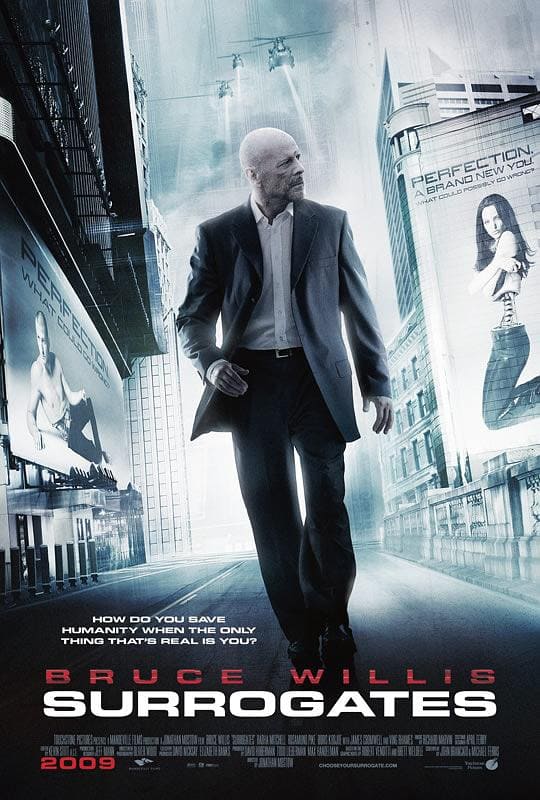Surrogates (2009) is a thought-provoking sci-fi movie that blends action, futuristic technology, and ethical dilemmas into a gripping narrative. Directed by Jonathan Mostow and starring Bruce Willis, Surrogates explores a world where humans live in isolation and interact with the world through robotic avatars called “surrogates.” This article dives deep into the movie’s plot, characters, production, symbolism, and its impact on science fiction cinema. Whether you’re a fan of dystopian themes or just love a good action thriller, this Surrogates review has everything you need.
Table of Contents
Introduction to Surrogates 2009 Movie
Released in 2009, Surrogates presents a near-future society where technological advancements have led to the widespread use of humanoid robots. These robots, or surrogates, are controlled remotely by their human operators who stay safe at home. The film is based on the 2005–2006 comic book series The Surrogates by Robert Venditti and Brett Weldele.
The core of the story revolves around FBI agent Tom Greer (played by Bruce Willis), who is assigned to investigate the mysterious murder of a surrogate and its human operator. What starts as a routine investigation soon uncovers a vast conspiracy that challenges the very foundation of surrogate technology.
Detailed Plot Summary of Surrogates
The movie opens with a brief history of surrogate technology. In this world, humans no longer leave their homes, instead using idealized robotic versions of themselves to navigate society. These surrogates are stronger, more attractive, and less vulnerable than real people, creating a perfect illusion of life.
When the son of the surrogate technology’s inventor is found murdered, Tom Greer is brought in to investigate. Initially operating through his own surrogate, Greer’s journey takes a sharp turn when his surrogate is destroyed. Forced to confront the world in his vulnerable human form, he uncovers hidden truths about the surrogate industry, its origins, and a resistance movement that seeks to return humanity to its natural state.
The film climaxes in a moral and philosophical dilemma: Should the surrogate system continue, or should humanity embrace its flawed but authentic self once more?
See Also
- Mickey 17 (2025): Full Movie Review, Cast, Plot, and Everything You Need to Know
- Captain America Brave New World (2025): Full Review, Cast, Storyline, and More
Cast and Characters
- Bruce Willis as Agent Tom Greer – A seasoned FBI agent who becomes disillusioned with the surrogate system.
- Radha Mitchell as Agent Jennifer Peters – Greer’s partner who supports him through the investigation.
- Rosamund Pike as Maggie Greer – Tom’s wife, who is emotionally distant and overly reliant on her surrogate.
- James Cromwell as Dr. Lionel Canter – The original inventor of surrogates who becomes a key figure in the film’s climax.
- Ving Rhames as The Prophet – A mysterious leader of the anti-surrogate movement.
Each character embodies different perspectives on the use of surrogates, adding depth and complexity to the narrative.
Themes and Symbolism in Surrogates

The movie Surrogates explores several themes that are highly relevant in today’s increasingly digital world:
- Loss of Human Connection – By outsourcing physical presence, people become disconnected from reality and each other.
- Identity and Perception – Surrogates allow individuals to present idealized versions of themselves, raising questions about authenticity.
- Technology and Ethics – The film questions the moral implications of hiding behind machines.
- Security vs. Freedom – While surrogates offer safety, they also remove personal responsibility and freedom of expression.
Symbolically, the destruction of surrogates at the end represents a return to authenticity and the embrace of human imperfections.
Surrogates and Real-World Technology
Although the concept might seem far-fetched, Surrogates draws from real trends in virtual reality, robotics, and artificial intelligence. The idea of controlling avatars is already present in online gaming, social media, and VR. The film extrapolates these trends to create a plausible dystopian future.
The ethical questions posed by Surrogates are becoming increasingly relevant. As companies develop lifelike robots and AI companions, society will need to address similar dilemmas about identity, autonomy, and human connection.
Cinematography and Visual Effects
Surrogates uses a distinct visual style to differentiate between surrogate and human realities. Surrogates appear flawless, with smooth skin and perfect posture, while humans often look tired and disheveled. This contrast reinforces the film’s themes of authenticity vs. artificiality.
The visual effects, especially the transition scenes between the real world and the digital interface, are well-executed. The CGI is used effectively without overshadowing the story, allowing the viewer to stay immersed in the narrative.
Directing and Screenplay
Director Jonathan Mostow delivers a tightly-paced film that balances action with philosophical inquiry. The screenplay, adapted by Michael Ferris and John Brancato, remains faithful to the source material while simplifying certain aspects for cinematic clarity. While some critics argue that the film didn’t fully explore its deeper themes, others appreciate its concise storytelling and clear message.
Critical Reception of Surrogates
Upon release, Surrogates received mixed reviews from critics. Some praised its originality and timely message, while others felt it lacked emotional depth. The film currently holds a 37% rating on Rotten Tomatoes but has since gained a cult following among sci-fi fans.
Audiences appreciated Bruce Willis’s performance and the film’s intriguing concept. Over time, its relevance has only grown, especially as society becomes more dependent on technology.
Box Office and Commercial Performance
With a budget of approximately $80 million, Surrogates earned around $122 million worldwide. While not a massive box office hit, it performed moderately well and maintained a strong presence in home media sales. Its budget-to-profit ratio suggests that it was a financially viable project for Touchstone Pictures.
Legacy and Cultural Impact
Surrogates has inspired discussions on digital identity, robotics, and the ethical use of technology. It has been cited in academic papers and tech conferences as a cultural touchstone for debates about human-robot interaction.
The movie’s influence is evident in later media, including shows like Black Mirror and Westworld, which explore similar concepts in more detail. Its comic book origins have also kept it relevant in the graphic novel community.
Comparing Surrogates with Similar Films
Fans of Surrogates may also enjoy movies with similar themes:
- I, Robot (2004) – Another sci-fi thriller exploring human-robot relations.
- Avatar (2009) – Released the same year, it also explores identity through remote-controlled avatars.
- The Matrix (1999) – Questions reality and perception in a digitally simulated world.
- Ready Player One (2018) – Explores escapism and digital identity in virtual reality.
- Ex Machina (2014) – Focuses on AI and ethical dilemmas of consciousness.
These comparisons highlight Surrogates’ place within the broader canon of futuristic, philosophical science fiction.
Final Thoughts: Why Surrogates (2009) Still Matters
Even over a decade after its release, Surrogates (2009) remains highly relevant. It challenges viewers to think critically about their relationship with technology and the consequences of trading authenticity for convenience. While it may not have achieved blockbuster status, its message continues to resonate with new generations.
In a world increasingly mediated by screens and avatars, Surrogates serves as a cautionary tale—one that asks us to remember what it means to be truly human.
Stay tuned for more deep-dive reviews of classic and cult-favorite science fiction films, only on shadefy.com.
Source and Reference
Surrogates on IMDB, https://www.imdb.com/title/tt0986263



3 comments